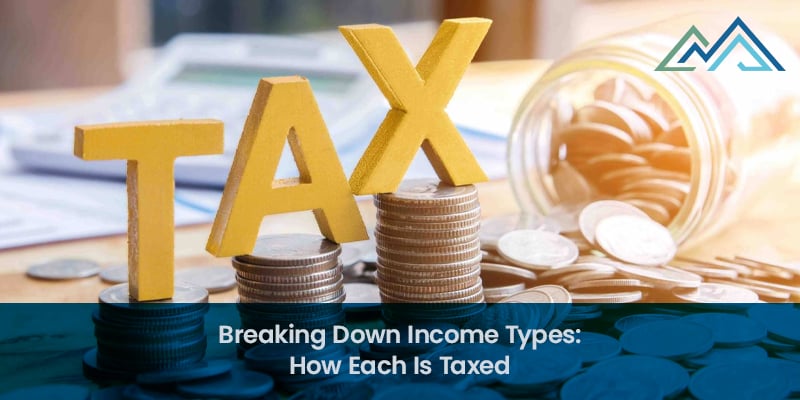Anyone with multiple income streams knows that tax preparation becomes complicated when there are different types of income to consider. The United States tax code is complex and difficult to understand at times. When you file your taxes, it’s essential to understand how each part of your income will be taxed.
At CMP, we work with taxpayers at every income level, including individuals and businesses. It’s our goal to ensure that our clients understand how the tax laws apply to them and make sure they pay what they owe without overpaying. With that in mind, here is our guide to the various sources of income and how they are taxed.

What is Considered Income?
Income is a broad term that may refer to anything of value that an individual or a business receives in return for goods or services or from investing capital. Income may come from a variety of sources, including the following:
- Hourly labor
- Day labor
- Salaried work
- Retail
- Interest
- Returns on investments
- Royalties
The 16th Amendment to the United States Constitution gives the federal government the power to tax income. Most states also tax residents’ income, but in nearly every case, they use the federal income tax system as a jumping-off point.
On the federal level, there are three terms related to income tax that you should know.
- Gross income. Your gross income is the sum of all your income regardless of its source or derivation. It must include your salary, hourly pay, gig work, investment earnings, interest, and even money that you might win in a lawsuit.
- Adjusted gross income. Your adjusted gross income, or AGI, refers to your gross income minus any allowed deductions you take on your tax return.
- Taxable income. Your taxable income is the amount that the government is allowed to tax after deductions and any necessary adjustments, including tax credits.
On the simplest level, income is any money you earn from any source. Paying taxes on income that comes from multiple sources requires knowledge and may require professional guidance from an accountant.
What’s the Importance of Knowing the Different Types of Income?
When you file your taxes, you’ll need to understand the different types of income. While tax filings can be pretty simple for some taxpayers, they are complex for others, particularly those in the highest income brackets.
The most important reason to know the different types of income and how they are taxed is that you’ll be less likely to make costly mistakes on your state or federal tax return. Anybody who earns an income has an obligation to pay taxes on it. Mistakes may be costly in two ways;
First, there’s a risk that you could underpay your taxes. When underpayments occur, the Internal Revenue Service has the right to charge both penalties and late fees. These can add up quickly, resulting in thousands of dollars of additional tax liability.
Second, there is a risk that you might end up paying more than you owe. An overpayment takes money out of your pocket, and you’ll need to file an amended return to get credit for the amount that you overpaid.
The best way to avoid both issues is to learn about the different types of income and file your taxes with an understanding of what you owe and why.
What Are the Different Types of Income?
To help avoid mistakes or overpayments when you file your federal income tax return, here is our overview of the different types of income and how they are taxed.
Earned Income
Earned income is income you earn from work, including salary, hourly wages, commissions, bonuses, tips, and net earnings from self-employment. It may also include union strike benefits, long-term disability, and certain income from your deferred retirement compensation.
Your earned income is taxed in two ways; FICA (Social Security and Medicare Tax) and income tax withholdings. FICA is withheld from all wages earned. Social Security taxes are 12.4% of your income, with half being paid by your employer and the other half coming from your pay. If you’re self-employed, you will pay both halves, but the employer half is deductible. For most taxpayers, FICA will be 7.65% of your gross paycheck.
The second type of tax on earned income may also be withheld from your paycheck and is your income tax. Your employer will withhold income taxes based on the information you provided on your W-4 form. Any state or federal income taxes withheld from your paycheck will be applied toward your tax liability at the end of the year. Any taxes paid over and above what you owe will be refunded to you when you file your tax return.
Business Income
Business income is income your business earns by providing goods or services to customers or clients. Any holding you operate as a business may generate business income. For example, if you own one or more rental properties, the rent paid by your tenants may be considered business income.
For the purposes of taxes, business income is treated the same as ordinary income. Business income is subject to tax on the net income after allowable deductions. Expenses and/or losses may offset some of your business income, reducing the amount of tax you’ll be required to pay.
Your business structure determines business income tax. Some business structures, including sole proprietorships, partnerships, S corporations, and some LLCs, are pass-through organizations. The owners claim the pass-through business income as personal income and pay taxes accordingly. C corporations are entities that are kept separate from individuals and must pay taxes separately. C Corporations are taxed at a rate of 21% on the net taxable income of the business. In addition, there is a new minimum federal business tax of 15% that applies to all corporations earning $1 billion or more in annual profits.
Capital Gains Income
Capital gains income is income you earn from selling an investment. Investments that are considered capital gains may include stocks, bonds, certain collectibles, and real estate and are taxed as capital gains if you have held the investment for at least a year before selling. (Holdings that you sell within one year of purchase are considered short-term gains and taxed at the ordinary income tax rate.)
The capital gains tax at the federal level falls for 2024 into three brackets, as follows:
- 0% if your income is less than $47,026 (single) or $94,051 (married filing jointly)
- 15% if your income is between $47,026 and $518,900 (single) or between $94,051 and $583,750 (married filing jointly)
- 20% if your income is over $518,901 (single) or $583,751 (married filing jointly)
See the below chart from Nerdwallet for more brackets.

You can reduce your capital gains tax by offsetting your gains with losses or holding onto investments for longer. The maximum loss you can claim without an offsetting gain is $3,000 per year, but if you have higher losses, you can carry them forward and use them in a later year.
Passive Income
Passive income is unearned income, meaning that it isn’t paid in return for labor, goods, or services and is the opposite of active income. Examples may include investment income, income from a business in which you don’t actively participate, and rental activities. It’s common for high-income earners to have multiple passive income streams from their investments.
In most cases, passive income is taxed as ordinary income. Passive losses are generally subject to limitations. However, if you actively participate in a rental real estate activity, you do have the option of deducting up to $25,000 in passive losses against your ordinary income if you earn less than $100,000 per year. The deduction begins to phase out over $100,000 of income and is not allowed If you earn more than $150,000 per year.
Portfolio Income
Portfolio income is investment income you earn from your investment portfolio and includes dividend payments, interest, and capital gains. We’ve already discussed capital gains, but income from dividend stocks and interest is not taxed in the same way.
Dividend payments fall into two categories, qualified and ordinary. Qualified dividends are taxed at a maximum rate of 20% and must meet the IRS requirements to qualify. Ordinary dividends are taxed as ordinary income, as their name implies.
Interest payments may come from investments or a savings account at your financial institution. You must report any interest payments over $10 to the IRS, and they are taxed as ordinary income.
Rental Income
Rental income is income you earn from renting out residential or commercial properties. Rental properties are often purchased as investments, but charging rent will mean that you are required to pay income tax on what you collect after applicable deductions.
The IRS considers rental income to be ordinary income for taxation purposes. Keep in mind that you may be able to offset some of what you owe by deducting expenses related to maintaining your property, including repairs and depreciation.
Royalty Income
Royalty income is income that you earn from an asset you own, such as a patent, copyright, or natural resource. A royalty is charged when someone wants to use your intellectual property or other assets and pays you for the right to do so. Most of us are familiar with the idea of musical artists earning royalties when their songs are used in movies or television shows, and in some cases, they can be a reliable source of income.
As a rule, royalty income is taxed as ordinary income and must be reported to the IRS in Part I of Schedule E. The only exception is if you are a self-employed artist, writer, or inventor or you hold an operating gas, oil, or mineral interest, in which case you must report your royalty income and expenses on Schedule C.
Self-Employment Income
Self-employment income is a type of earned income. It is differentiated from employment income in that the taxpayer works for themselves and as a result, must pay both the individual portion of their payroll taxes (including Social Security taxes and Medicare taxes) and the employer’s portion. Self-employed individuals must report their income to the IRS and typically must pay estimated taxes on a quarterly basis.
The total self-employment tax for 2024 is 15.3%, which includes the 12.4% Social Security tax plus 2.9% in Medicare taxes. In addition to paying the self-employment tax, people who are self-employed or gig workers must also estimate their income tax and pay that on a quarterly basis. Most self-employed individuals must reconcile their total income against their quarterly filings and payments made throughout the year. Keep in mind that if you are self-employed, you may deduct the employer portion of your self-employment taxes when you file your return, and doing so will offset some of your tax liability.
Government-Sponsored Retirement Benefits and Tax-Deferred Investments
Government-sponsored pensions and annuities are typically taxable at the ordinary tax rate based on your income. The ordinary tax rate applies if you receive monthly or annual payouts, but you may pay more if you opt for a lump-sum payout at the time you retire or at any time thereafter. The same is true of any tax-deferred retirement income, including payouts from 401(k) or traditional IRA accounts.
Keep in mind that if you have a Roth IRA or Roth 401(k) account, you will have made contributions on a post-tax basis and will not be required to pay income taxes on your withdrawals.
Tax Professionals Can Help You Navigate the Complexities of Different Categories of Income
Understanding the various kinds of income and how they are taxed is essential for tax planning and retirement planning purposes. The information we have included here will help you as you engage in income tax planning and file your tax returns. Keep in mind that you may have state requirements as well.
Do you need assistance from an income tax professional to help you avoid overpayments and prepare an accurate tax return? CMP is here to help! Contact us today to learn more about our income tax services and schedule a free consultation.


















